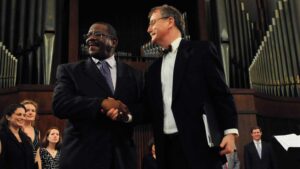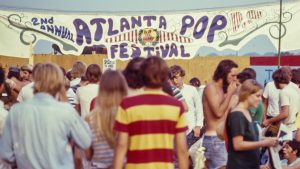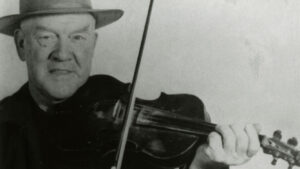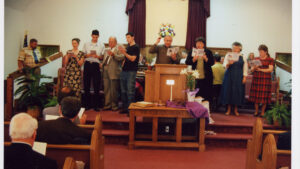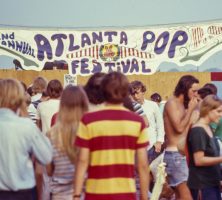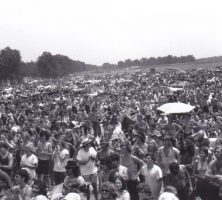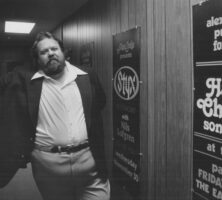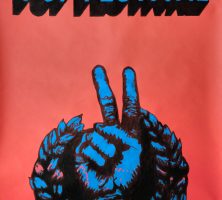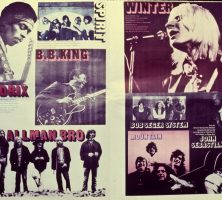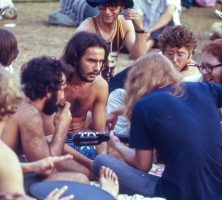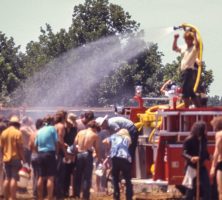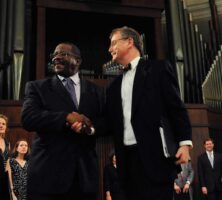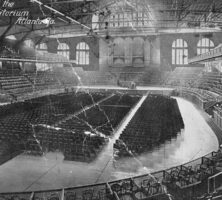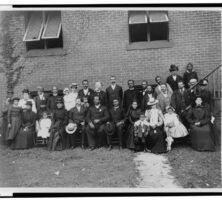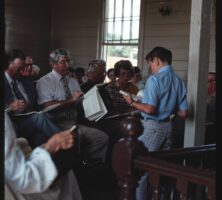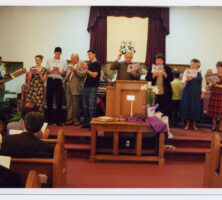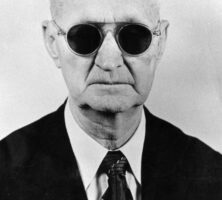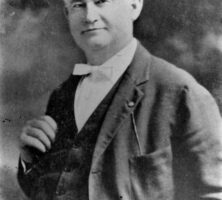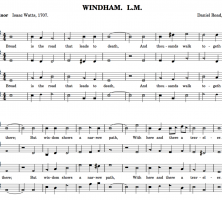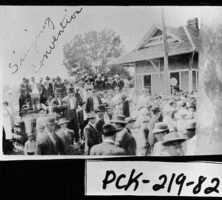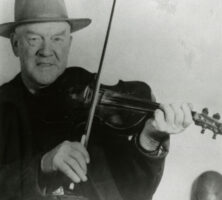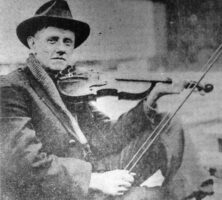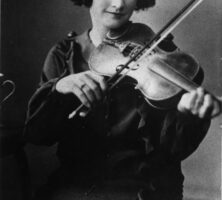The New Georgia Encyclopedia is supported by funding from A More Perfect Union, a special initiative of the National Endowment for the Humanities.
Organizers of the second Atlanta International Pop Festival initially required tickets to enter the gated festival, shown here on opening day, July 3, 1970. However, unruly crowds soon prompted the organizers to allow free entry.
Photograph by Earl McGehee
The New Georgia Encyclopedia does not hold the copyright for this media resource and can neither grant nor deny permission to republish or reproduce the image online or in print. All requests for permission to publish or reproduce the resource must be submitted to the rights holder.
The crowd at the second Atlanta International Pop Festival in Byron. Estimates vary, but the festival likely attracted between 200,000 and 300,000 people.
Courtesy of Atlanta Journal-Constitution.
The New Georgia Encyclopedia does not hold the copyright for this media resource and can neither grant nor deny permission to republish or reproduce the image online or in print. All requests for permission to publish or reproduce the resource must be submitted to the Atlanta Journal-Constitution.
Alex Cooley, pictured in 1978, owned and operated a number of the best-known rock venues in Atlanta, including Alex Cooley's Electric Ballroom and the Tabernacle. In 1987 Cooley was inducted as a nonperformer into the Georgia Music Hall of Fame.
Courtesy of Atlanta Journal-Constitution.
The New Georgia Encyclopedia does not hold the copyright for this media resource and can neither grant nor deny permission to republish or reproduce the image online or in print. All requests for permission to publish or reproduce the resource must be submitted to the Atlanta Journal-Constitution.
This homemade blacklight poster is designed after the 1970 cover of the Second Annual Atlanta International Pop Festival newspaper.
Photograph by Earl McGehee
The New Georgia Encyclopedia does not hold the copyright for this media resource and can neither grant nor deny permission to republish or reproduce the image online or in print. All requests for permission to publish or reproduce the resource must be submitted to the rights holder.
This centerfold from the second Atlanta International Pop Festival program showcases artists including Jimi Hendrix, B.B. King, and The Allman Brothers Band.
Photograph by Earl McGehee
The New Georgia Encyclopedia does not hold the copyright for this media resource and can neither grant nor deny permission to republish or reproduce the image online or in print. All requests for permission to publish or reproduce the resource must be submitted to the rights holder.
The second Atlanta International Pop Festival took place July 3-5, 1970, in Byron.
Photograph by Earl McGehee
The New Georgia Encyclopedia does not hold the copyright for this media resource and can neither grant nor deny permission to republish or reproduce the image online or in print. All requests for permission to publish or reproduce the resource must be submitted to the rights holder.
Scorching temperatures and high winds marked the second Atlanta International Pop Festival. Firetrucks were brought in to hose down attendees while medics treated sunburns.
Photograph by Earl McGehee
The New Georgia Encyclopedia does not hold the copyright for this media resource and can neither grant nor deny permission to republish or reproduce the image online or in print. All requests for permission to publish or reproduce the resource must be submitted to the rights holder.
Litter quickly covered the ground at the second Atlanta International Pop Festival in Byron.
Photograph by Earl McGehee
The New Georgia Encyclopedia does not hold the copyright for this media resource and can neither grant nor deny permission to republish or reproduce the image online or in print. All requests for permission to publish or reproduce the resource must be submitted to the rights holder.
The Reverend Dwight Andrews (left), of First Congregational Church, and Steven Darsey, of Meridian Herald, are pictured at the Atlanta Music Festival in 2009. The two cofounded the festival in 2001.
Courtesy of Meridian Herald
The New Georgia Encyclopedia does not hold the copyright for this media resource and can neither grant nor deny permission to republish or reproduce the image online or in print. All requests for permission to publish or reproduce the resource must be submitted to the rights holder.
The Atlanta Auditorium and Armory (later Atlanta Municipal Auditorium), pictured circa 1916, was the venue in 1910 for the first concert presented by the Atlanta Colored Music Festival Association. The concerts continued annually until about 1918.
Courtesy of Georgia Archives, Vanishing Georgia, # ful0183.
The New Georgia Encyclopedia does not hold the copyright for this media resource and can neither grant nor deny permission to republish or reproduce the image online or in print. Requests for permission to publish or reproduce the resource should be submitted to the Georgia Archives.
Members of the First Congregational Church, including the Reverend Henry Hugh Proctor (standing seventh from left), in Atlanta are pictured circa 1899. Today the church is an affiliate of the United Church of Christ, which formed in 1957.
Courtesy of Library of Congress, Prints and Photographs Division
The New Georgia Encyclopedia does not hold the copyright for this media resource and can neither grant nor deny permission to republish or reproduce the image online or in print. All requests for permission to publish or reproduce the resource must be submitted to the rights holder.
Henry Hugh Proctor, the minister at First Congregational Church in Atlanta from 1894 until 1920, is pictured circa 1900. In 1910 Proctor founded the Atlanta Colored Music Festival Association, which produced annual concerts by classically trained African American performers for nearly a decade.
Courtesy of Library of Congress, Prints and Photographs Division
The New Georgia Encyclopedia does not hold the copyright for this media resource and can neither grant nor deny permission to republish or reproduce the image online or in print. All requests for permission to publish or reproduce the resource must be submitted to the rights holder.
The sound of Sacred Harp may vary a bit from region to region, and white singers have different styles from African American singers. But regardless of location or race, Sacred Harp sounds unlike academic choral singing or gospel singing, in which melody dominates and harmony embellishes and supports it.
Courtesy of Library of Congress, Prints and Photographs Division
The New Georgia Encyclopedia does not hold the copyright for this media resource and can neither grant nor deny permission to republish or reproduce the image online or in print. All requests for permission to publish or reproduce the resource must be submitted to the rights holder.
The Dewey Caldwell Memorial Singing, a singing convention held at Abilene Baptist Church in Carrollton on March 24, 2002.
Courtesy of Wayne W. Daniel
The New Georgia Encyclopedia does not hold the copyright for this media resource and can neither grant nor deny permission to republish or reproduce the image online or in print. All requests for permission to publish or reproduce the resource must be submitted to the rights holder.
The Reverend Andrew Jenkins of Atlanta (pictured here in 1954) was a leading composer of songs popular among southern gospel singers. He has been credited with more than 800 compositions, of which more than two-thirds are sacred songs.
Courtesy of Mary Lee Eskew Bowen
The New Georgia Encyclopedia does not hold the copyright for this media resource and can neither grant nor deny permission to republish or reproduce the image online or in print. All requests for permission to publish or reproduce the resource must be submitted to the rights holder.
Charlie D. Tillman (photo taken ca. 1930), who called Atlanta home for most of his career, was a pioneer composer, performer, and publisher of southern gospel music. During the almost sixty years that he was involved in the music business, he wrote some one hundred songs and published twenty-two songbooks.
Courtesy of Charles L. Douglas
The New Georgia Encyclopedia does not hold the copyright for this media resource and can neither grant nor deny permission to republish or reproduce the image online or in print. All requests for permission to publish or reproduce the resource must be submitted to the rights holder.
The shape-note system in The Sacred Harp uses a different shape to represent each of the four syllables in the musical scale: a triangle (fa), a circle (sol), a rectangle (la), and a diamond (mi).
The tune "Windham" as it appears in The Sacred Harp, 1911 edition. Image from Wikimedia.
The New Georgia Encyclopedia does not hold the copyright for this media resource and can neither grant nor deny permission to republish or reproduce the image online or in print. All requests for permission to publish or reproduce the resource must be submitted to the rights holder.
Members of a gospel singing convention gather by the train depot in Jasper, circa 1910. Two conventions were held in the town each year, in May and September, and attracted large crowds from neighboring communities.
Courtesy of Georgia Archives, Vanishing Georgia, #
pck219-82.
The New Georgia Encyclopedia does not hold the copyright for this media resource and can neither grant nor deny permission to republish or reproduce the image online or in print. Requests for permission to publish or reproduce the resource should be submitted to the Georgia Archives.
Members of a singing school at Wolf Fork Baptist Church in Rabun County gather in front of the church for a photograph (1909). This structure was also used as a school at one time.
Courtesy of Georgia Archives, Vanishing Georgia, #
rab068.
The New Georgia Encyclopedia does not hold the copyright for this media resource and can neither grant nor deny permission to republish or reproduce the image online or in print. Requests for permission to publish or reproduce the resource should be submitted to the Georgia Archives.
Gid Tanner was one of the most widely recognized names among country music enthusiasts of the 1920s and 1930s. The group that he headed, Gid Tanner and His Skillet Lickers, was one of the most influential string bands that recorded during the formative years of the country music industry.
Courtesy of Phil Tanner
The New Georgia Encyclopedia does not hold the copyright for this media resource and can neither grant nor deny permission to republish or reproduce the image online or in print. All requests for permission to publish or reproduce the resource must be submitted to the rights holder.
Fiddlin' John Carson, pictured circa 1924, began playing fiddle on Atlanta's WSB radio station in 1922. On June 14, 1923, the country-music recording industry was launched when Carson made his first phonograph record. His recording career, which yielded some 165 recorded songs, lasted into the 1930s.
Photograph by Wilbur Smith
The New Georgia Encyclopedia does not hold the copyright for this media resource and can neither grant nor deny permission to republish or reproduce the image online or in print. All requests for permission to publish or reproduce the resource must be submitted to the rights holder.
A. A. Gray of Tallapoosa was the most frequently documented first-place winner of the contests sponsored by the Georgia Old Time Fiddlers' Conventions, taking home the honors in 1918, 1921, 1922, and 1929.
Courtesy of Earl Gray
The New Georgia Encyclopedia does not hold the copyright for this media resource and can neither grant nor deny permission to republish or reproduce the image online or in print. All requests for permission to publish or reproduce the resource must be submitted to the rights holder.
Anita Sorrells Wheeler of Atlanta was the only woman to win the state fiddling championship during the heyday of the Georgia Old-Time Fiddlers' Conventions. She won first place in 1931 and 1934.
Courtesy of Anita Mathis
The New Georgia Encyclopedia does not hold the copyright for this media resource and can neither grant nor deny permission to republish or reproduce the image online or in print. All requests for permission to publish or reproduce the resource must be submitted to the rights holder.
